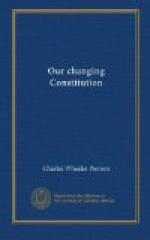It is interesting to note that two of the amendments (No. XI, designed to prevent suits against a state without its permission by citizens of another state, and No. XVI, paving the way for the Income Tax) were called forth by unpopular decisions of the Supreme Court, and virtually amounted to a recall of those decisions by the people. These instances demonstrate the possibility of a recall of judicial decisions by constitutional methods, and tend to refute impatient reformers who preach the necessity of a more summary procedure. Such questions, however, lie outside the scope of this book. We emphasize here the fact that the great achievement of the Constitution was the creation of a dual system of government and the apportionment of its powers. That was what made it “one of the longest reaches of constructive statesmanship ever known in the world."[1] It offered the most promising solution yet devised for the problem of building a nation without tearing down local self-government.
[Footnote 1: Fiske: “The Critical Period of American History,” p. 301.]
John Fiske, the historian, writing of the importance of preserving the constitutional equilibrium between nation and states, said:[1]
If the day should ever arrive (which God forbid!) when the people of the different parts of our country shall allow their local affairs to be administered by prefects sent from Washington, and when the self-government of the states shall have been so far lost as that of the departments of France, or even so far as that of the counties of England—on that day the progressive political career of the American people will have come to an end, and the hopes that have been built upon it for the future happiness and prosperity of mankind will be wrecked forever.
[Footnote 1: Id., p. 238.]
If allowance be made for certain extravagances of statement, these words will serve as a fitting introduction to the discussions which follow.
II
THE SUPREME COURT OF THE UNITED STATES
The Constitution effected an apportionment of the powers of government between nation and states. The maintenance of the equilibrium thus established was especially committed to the Supreme Court. This novel office, the most important of all its great functions, makes the Court one of the most vital factors of the entire governmental scheme and gives it a unique preeminence among the judicial tribunals of the world.




